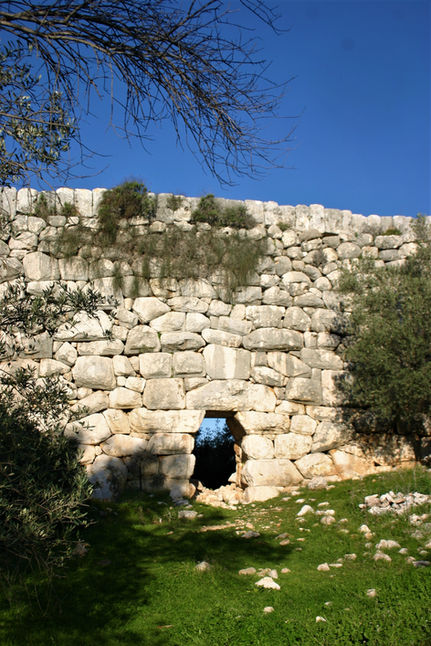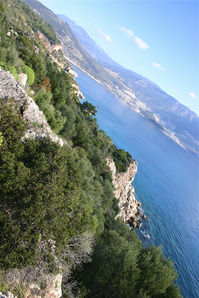
The Lycian Way section Delikkemer to Patara. 9km

You join the Lycian Way near the ridge of a valley, topped off by the Roman engineering marvel of Delikkemer, a reverse siphon system, part of the aqueduct that brought water to Patara, the metropolis of Lycia. The walk follows the aqueduct system as it contours around the hillside before it gets lost in the forest.
Picking up the forest road later, you start to get views of the fertile Xanthos valley and also the dunes and remains of Patara, before picking up the aqueduct again as you descend to the magnificent site of Patara itself.
On arrival at the site we recommend that you take the time to make a good visit of the remains before heading towards the beach, where there is beer available for sunset!

Patara
Patara was the capital of Lycia during the Roman imperial period, after Xanthos was destroyed by Brutus in the 1st C BC. The importance was the Harbour, which with the massive increase of trade during the Roman Empire brought great wealth to the town, as Patara became the centre of trade and governance for the whole of Lycia province. This is reflected in the size and grandeur of the remains to be found here, many still waiting under the sand.
The first major monument you will see is the triumphal arch dedicated to the emperor Vespasian (69-79AD) who presumably visited Patara during his reign. The Archway was connected to the city walls which you can just make out as they follow the road up the hill, all the way to the ruined fortress on the hill to the east. This gives some impression of the size of the city at its apogee. Turn to the west to descend to the ‘Harbour baths’, a large building with huge arched entrance way and bay windows rather similar to the Bathhouse at Tlos. Note the excavated crossroads. The reedy area nearby was the inner harbour in old times, and the harbour bath would be the first port of call for most of the arrivals in the town, who after weeks at sea would be smelling a bit ripe! Also it was a way of the town authorities to inspect the newcomers for any signs of infectious disease.
Walk back to the road and turn right, walk for about 200 meters to find the Church on the right, a of typical Byzantine design, with entrance hall (narthex), Central vault (nave), 2 aisles on either side and a semi circular Apse, facing east, where the alter was hidden behind the Templon, a highly decorated barrier, creating a sanctuary which only priests were allowed to enter.
The church was built using many re-used stones from other, earlier buildings; note the inscribed plinth making up part of the flooring, and the remains of a red granite column. (Which you can see the rest of later in the day)
St. Nicholas was born here in the 4th C AD, the only son of wealthy Christian parents, his parents died when he was still young and he was brought up by his uncle (Also called Nicholas) the Bishop of Patara, with a good inheritance.
Nicholas was a very pious young man and entered the priesthood early.
According to the legend, Nicholas was in Myra (now Demre, 40km from Kaş) where he was working as a priest. The Bishop of Myra had recently died, and the Archbishop was having difficulty finding a successor. God came to the archbishop in a dream, and told him to go spend the night in the church, and the first person who comes to pray in the morning would be the new bishop. Of course Nicholas came first and became the bishop of Myra.
Nicholas was known for his charity and frequently gave secret donations to the poor, without revealing his identity.
The most famous myth concerns three sisters who were too poor to find dowries therefore were unlikely to be able to find husbands. The eldest daughter was preparing to sell herself into slavery or prostitution in order to find money for the younger girls. Nicholas threw gold coins down their chimney so that the girl would find the money in the morning, some of it landing in the girl’s socks which had been hung at the chimney to dry. From this the story of Santa and gifts and chimneys was born.
Nicholas was also capable of performing miracles: During a famine at Myra one of the emperor’s grain ships was traveling from Egypt to Constantinople. The ship stopped for water at Myra, Nicholas led a group of the town elders to plead for the captain to give some grain to the town and stop starvation. Of course the captain was not happy about this, as to steal the emperor’s grain would mean death when he arrived at the capital, however Nicholas’s pleading won through and half the grain on the ship was handed over. This grain lasted 2 years and there was even enough to sow the next year. Miraculously, when the grain arrived at Constantinople there was no grain missing.
St Nicholas was not just a mythological miracle worker, but a true historical character, and important theologian, who took part in the grand council of the church at Nicea, when the basic creed of the Christian church still in force today, was decided upon.
When he died, his remains were interred in Myra (Demre) in a church built in his honour.
The remains were taken to Bari in Italy, in the year 1087, after the Selçuk Turks defeated the Byzantine army and flooded into Asia Minor. The bones are still in Bari and venerated in a special church. The Turkish Government has now officially requested the return of the bones to Myra.
St. Nicholas is the patron saint of: Sailors, Prostitutes, Russia, archers, thieves, children, students.
He is also the patron saint of Aberdeen, Amsterdam, Barranquilla, Bari, Beit Jala, Fribourg, Huguenots, Kozani, Liverpool, Siggiewi, and Lorraine. He was also a patron of the Varangian Guard of the Byzantine emperors, who protected his relics in Bari.
Continue along the road till you come to a small junction. Turn Left up the hill for 50 meters and look at the remains under the now roof. This is an example of a water control and distribution system, where the water from the aqueduct was delivered to different parts of the city, and the pressure was controlled. Note the large collection chamber and the smaller pipes leading from it. If you look round the back you can make out the route of the aqueduct into the chamber.
Return to the road and continue straight across the road, passing a gate. On your right we see a massive collection of stones, possibly from the temple of Apollo that was in Patara.
Apollo was believed to have been born near here at a place called Letoon.
According to the myth, Leto the queen of the Nereids (water nymphs) was seduced by Zeus and fell pregnant with the twin gods Apollo and Artemis.
When Zeus’s wife Hera found out she chased Leto from Olympos, and Leto Gave birth in Lycia (or on the Greek island, Delos)
Apollo was the great god of prophecy, and the oracles worked at Apollo’s greatest temples in Delos, Didima and at Patara, interpreting various natural signs, animal entrails or sacred springs, to give a cryptic message to the supplicants who traveled great distances and spent good amounts of money to get a good prediction.
Though the temple has not been positively identified, it was probably in this area.
Observe the 2nd large bathhouse on your right, known as the baths of Vespasian (Perhaps he was so impressed by the archway built in his honour, he gave money for the bathhouse to be built?) Although impressive in size, it is not worth visiting, but note the soot is still visible in the chimney of the furnace that heated the complex.
Look for the line of columns, and head towards it.
This was the main arcade of the town lined with showy columns and shops. The columns are all monolithic, made prom one piece of stone, and there are various different types of stone that you can find, blue granite, red granite, porphyry and pudding stone as well as the local limestone and pale marble. These columns were purely decorative and reflect the wealth of the city. Look out for the inscribed plinths that would have carried statues of emperors and local dignitaries. If you look carefully at the Greek inscriptions for long enough, you can see the names of emperors, M. Aurelius, Titus, Vespasian and Claudius, as well as the words Architect, Gymnasium.
From here it is possible to visit the ‘Temple of unknown Deity’ which you can see 200 meters distant if you follow the line of the colonnaded street. On the far side of this building there is an intricately carved doorway.
Turning back in the direction of the theatre, we first pass the very newly restored Boulitourion, the parliament chamber.
The Lycians were the first to develop a federative assembly in their republic, where each of the 30 or so Lycian cities sent representatives to the parliament in Patara. The number of representatives varied on the size of the city, with the smaller ones grouped together to have one representative. The biggest cities were Xanthos, Patara, Tlos, Myra, Olympos, Arycanda, Limyra who had 3 representatives each, the smaller 2 or 1. The representative elected the ‘Lyciarch’ who was the president for a year.
Being the first example of representative federal democracy, the Building has recently seen lots of interest, especially from USA, who see many parallels with their own democracy. The building has recently been restored, with funding from the Turkish Parliament.
Continue to the theater itself, and note the massive dedicatory inscription on the left (east) side of the stage building. Dedicated to Emperor Antonius Pius 138-161 AD, the theatre was originally constructed in Hellenistic times (330-80 BC) in the horse-shoe shape, during the roman period the theatre was enlarged, the stage building was built and a wall was built at the edge of the orchestra to protect the spectators from the animal and Gladiator displays which become popular during roman times
























